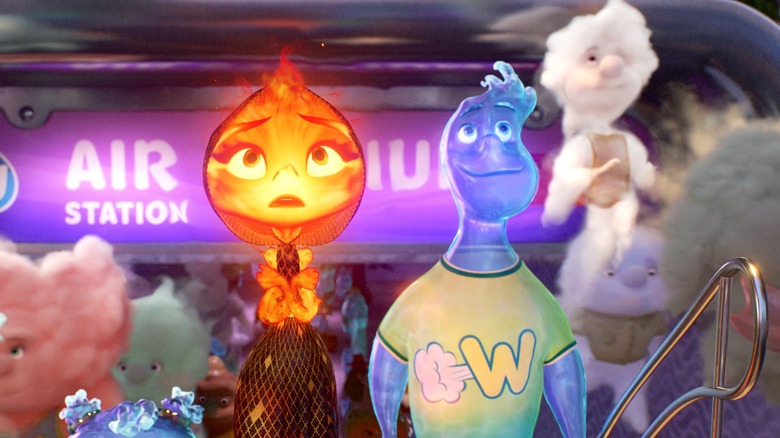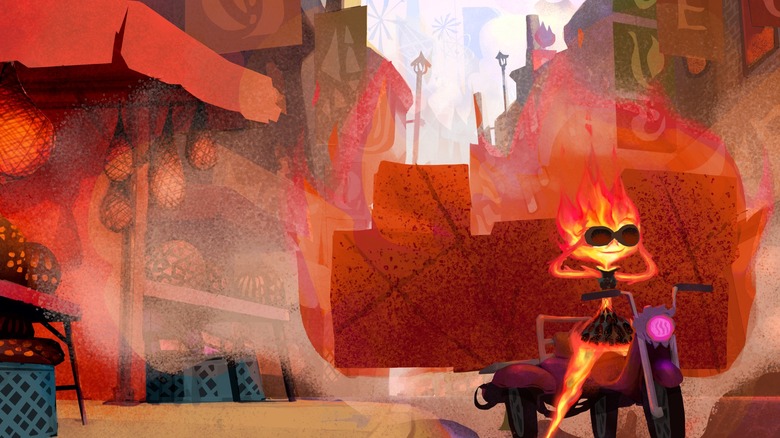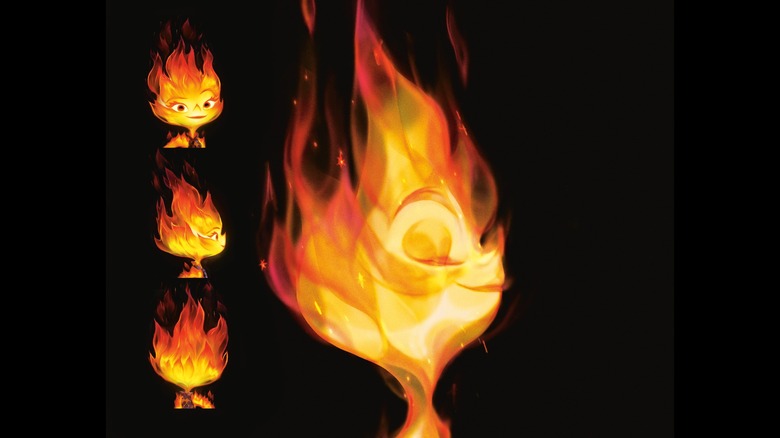Elemental Was Pixar's Most Technically Challenging Film, And It Shows
There were a few reasons that "Toy Story" changed the animation industry upon its release in 1995. As the first fully computer-animated feature film, obviously nothing had ever looked quite like it before. But if it had just been a flashy tech demonstration, it would've remained a historical oddity. All the rendering power and technical cleverness in the world won't earn more than a "wow, cool" from a select group of computer enthusiasts.
No, the reason that "Toy Story" won the hearts of a generation is that it used that incredible new tech to craft truly endearing characters and an adventure that perfectly balanced humor and heart. Pixar managed to build an empire on the success of "Toy Story" for that very reason, with the studio delivering nearly three decades of hits that put boundary-pushing technology hand-in-hand with timeless artistry.
You might think the technical side of their work would have become second nature in that time, but the creatives at Pixar have never been known to rest on their laurels. Each new project is a chance to explore new ways of telling stories, to try new things that animation has never done before. Their next film, this summer's "Elemental," turned out to be one of the most challenging projects Pixar has taken on in years. And as Looper saw during a visit to the studio, the way they overcame those challenges is nothing short of astounding.
Elemental continues Pixar's tradition of doing the impossible
"This isn't the first time Pixar's done something that seemed impossible," VFX supervisor Sanjay Bakshi said during a Q&A at the studio. "All of our films have technical challenges, but we haven't had one on the scale of 'Elemental' in a while. That's really exciting to us." Bakshi went on to demonstrate just how much technical power it takes to do the impossible, explaining that Pixar's "render farm" for "Toy Story" back in 1995 consisted of just under 300 computers. "Monsters, Inc." took nearly 700 computers, while "Finding Nemo" clocked in at about 1,000. Now, as the studio prepares "Elemental" for release, the core render farm on its Emeryville campus boasts more than 150,000 computers.
A close look at the cast and setting of "Elemental" makes it clear just what all those machines have been busy rendering. Ember (voiced by Leah Lewis), Wade (Mamoudou Athie), and the citizens of Element City are not just characters — they're living, breathing visual effects with uniquely dynamic ways of moving through their brightly-colored world. This meant creating animation models with an incredible degree of expressiveness. As directing animators Gwen Enderoglu and Allison Rutland revealed, where the average Pixar character model has about 4,000 points of articulation, Wade and Ember required about 10,000 each.
Of course, all of these efforts need to work in service of one goal above all others — to create endearing, vibrant characters who feel like so much more than the sum of their pixels.
Elemental required a whole new way of working for Pixar
"Character animation" and "effects animation" are usually two separate departments. One team focuses on the characters' performances, then the other comes in to create the waves, flames, explosions, or whatever other atmospheric elements make up the world of the film. Needless to say, that division of duties wouldn't work for this particular project. "'Elemental' was entirely unique, and it required us to work a bit backwards," explained production designer Don Shank. "It was a bit of a 'chicken and egg' type situation — what did we want to do artistically, and what could we do technically?"
This new way of working shook up the cycle of creativity, with the artistic and technical aspects working hand-in-hand on a level that was entirely new, even for Pixar. As Shank explained, "Our technical abilities informed and inspired design choices, and then those design choices in turn inspired new technology, which then inspired new designs."
As the crew demonstrated, a lot of trial and error went into finding exactly the right ways to make Ember and Wade into characters that will connect with audiences. Director Pete Sohn, whose personal stories laid the foundation for "Elemental," had some specific directives for the team. "Pete wanted these characters to emote like the elements," Bakshi explained. "Ember isn't just a standard Pixar character who we set on fire. She should really feel like she's made of fire."
All the elements come together to bring characters to life
Animators with 2D backgrounds experimented with ways that fire and water could express emotion, and the 3D character team applied those studies to the characters' movements. When Ember gestures, her arm flickers like licking flame, disappearing and reappearing with the flow of her motion. Wade flows and bubbles in a way that's constantly vibrant and alive without ever becoming distractingly amorphous or over-animated.
Machine learning has even found its place in Pixar's toolbox. Character supervisor Junyi Ling demonstrated a program written in-house at the studio called Neural Style Transfer, which could take a library of hand-animated flames created by the artists and dynamically apply them to Ember's performance, making her a truly living flame in a way that would have otherwise been impossible to sustain for a feature film, without ever losing the personal touch of an animator.
The crew of "Elemental" professes that they could not have made the movie ten years ago, and it's easy to see why they're excited about this bold new experiment in technique and technology. But as they have since "Toy Story," what they're really hoping to do is introduce characters who will live on in the hearts and minds of audiences. "I'm so proud of what the team's created," Sohn enthused. "It started as a very personal thing for me and it's turned into so much more, and I can't wait for everyone to see it this summer on the big screen."
"Elemental" arrives exclusively in theaters June 16.



